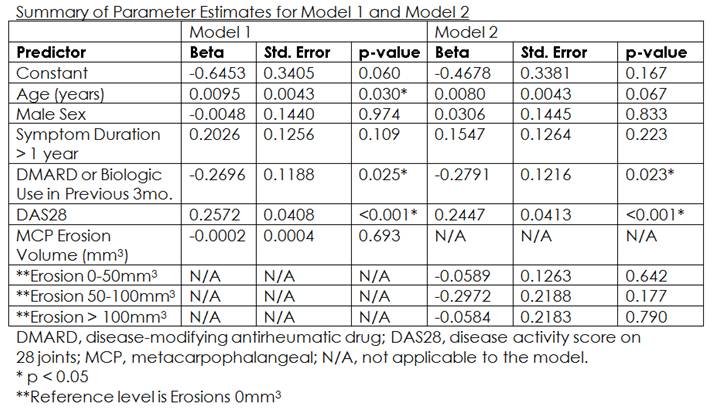Session Information
Date: Monday, November 9, 2015
Title: Imaging of Rheumatic Diseases Poster II: X-ray, MRI, PET and CT
Session Type: ACR Poster Session B
Session Time: 9:00AM-11:00AM
Background/Purpose: Functional ability of rheumatoid arthritis (RA) patients is reduced by both acute (inflammatory) and chronic (joint damage) disease manifestations. However, the impact of early erosive damage in small joints is not yet fully appreciated. Advances in automated erosion segmentation of magnetic resonance (MR) images, such as Early Erosions in Rheumatoid Arthritis (EERA) software, enable more reliable and precise measurement of erosions. Our objective was to develop multiple linear regression models to determine how small amounts of erosive damage contribute to loss of functional ability.
Methods: From a single rheumatology clinic, 131 patients satisfying early RA referral criteria were included. Clinical examinations, laboratory tests, MR images of both hands, and the Health Assessment Questionnaire – Disability Index (HAQ-DI) were captured. A single reader used EERA software to compute the total erosive damage in the metacarpophalangeal (MCP) joints, in mm3. A multiple linear regression model was constructed (Model 1), with HAQ-DI as the dependent variable, and age, sex, symptom duration < 1 year, DMARD or biologic use over preceding 3 months, 28 joint Disease Activity Score (DAS28), and MCP erosion volume as predictors. Model 2 was constructed identical to Model 1, except MCP erosion volume was categorized into: 0mm3, 0-50mm3, 50-100mm3 and >100mm3.
Results: Patients were 78% female, 77% Caucasian, mean (standard deviation) age 55.9 (13.3) years, symptom duration 4.2 (5.1) years, DAS28 4.48 (1.40), HAQ-DI 0.81 (0.71), with 50% using DMARD or biologic over the preceding 3 months. Mean erosive damage was low at 32.3 (78.5) mm3. Model 1 (R2=0.296, p<0.001) and Model 2 (R2=0.282, p<0.001) had similar parameter estimates. Each unit increase in DAS28 was associated with a 0.25 unit increase in HAQ-DI. DMARD or biologic use in the preceding 3 months was associated with 0.27 unit decrease in HAQ-DI. Age was significantly related to HAQ-DI in Model 1, but the effect was small (0.1 increase in HAQ-DI for 10 years age increase). Erosive damage to the MCP joints was not significantly related to HAQ-DI in either model.
Conclusion: Low amount of erosive damage was not associated with decreased functional ability. Low disease activity and concurrent DMARD or biologic therapy were associated with improved functional ability. Longitudinal models controlling for additional variables may help elucidate how early erosive damage influences functional ability.
To cite this abstract in AMA style:
Jessome M, Tomizza M, Beattie KA, Bensen WG, Bobba R, Cividino A, Emond PD, Gordon C, Hart L, Ioannidis G, Larche M, Lau A, Tavares R, Tytus S, Adachi JD. Does Computerized Segmentation of Early Erosions on Magnetic Resonance Imaging Predict Functional Ability in Rheumatoid Arthritis? [abstract]. Arthritis Rheumatol. 2015; 67 (suppl 10). https://acrabstracts.org/abstract/does-computerized-segmentation-of-early-erosions-on-magnetic-resonance-imaging-predict-functional-ability-in-rheumatoid-arthritis/. Accessed .« Back to 2015 ACR/ARHP Annual Meeting
ACR Meeting Abstracts - https://acrabstracts.org/abstract/does-computerized-segmentation-of-early-erosions-on-magnetic-resonance-imaging-predict-functional-ability-in-rheumatoid-arthritis/

